First Computer MB05WIW Notebook Computer With 802.11b WLAN Card User Manual 1 of 3
First International Computer Inc Notebook Computer With 802.11b WLAN Card 1 of 3
Contents
- 1. User Manual 1 of 3
- 2. User Manual 2 of 3
- 3. User Manual 3 of 3
User Manual 1 of 3
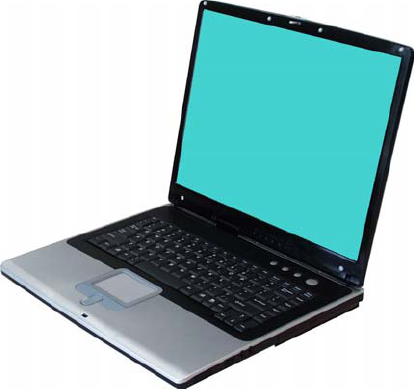
FIC
WB-B55
User Guide
First International Computer, Inc.

Notebook User Guide
1
Copyright©2003
All Rights Reserved - Printed in Taiwan
Notebook Computer User Guide
Original Issue: 2003/6
This manual guides you in setting up and using your new notebook computer.
Information in this manual has been carefully checked for accuracy and is
subject to change without notice.
No part of this manual may be reproduced, stored in a retrieval system, or
transmitted, in any form or by any means, electronic, mechanical, photocopy,
recording, or otherwise, without prior written permission.
Trademarks
Product names used herein are for identification purposes only and may be the
trademarks of their respective companies.
Microsoft, MS-DOS, Windows, and Windows Sound System are trademarks of
Microsoft Corporation.
Intel ®, Centrino™, Pentium ® M, Banias, Calexico are registered trademark
of Intel Corporation.
Sound Blaster, Sound Blaster Pro are trademarks of Creative Technology.
All other brands or product names mentioned in this manual are trademarks or
registered trademarks of their respective companies.

Notebook User Guide
2
FCC Information to User
Safety and Care Instructions
No matter what your level of experience with computers, please make sure you
read the safety and care instructions. This information can help protect you
and your computer from possible harm.
Radio and television interference
Warning: Use the specified shielded power cord and shielded signal cables
with this computer, so as not to interfere with radio and television reception. If
you use other cables, it may cause interference with radio and television
reception.
This equipment has been tested and found to comply with the limits for a
Class B digital device, pursuant to Part 15 of the FCC Rules. These limits are
designed to provide reasonable protection against harmful interference in a
residential installation. This equipment generates, uses and can radiate radio
frequency energy and, if not installed and used in accordance with the
instructions, may cause harmful interference to radio communications.
However, there is no guarantee that interference will not occur in a particular
installation. If this equipment does not cause harmful interference to radio or
television reception, which can be determined by turning the equipment off
and on, the user is encourage to try to correct the interference by one or more
of the following measures:
• Reorient or relocate the receiving antenna
• Increase the separation between the device and receiver
• Connect the device into an outlet on a circuit different from that to which
the receiver is connected.
• Consult the dealer or an experienced radio/television technician for help.

Notebook User Guide
3
You may find helpful the following booklet, prepared by the Federal
Communications Commission: Interference Handbook (stock number 004-
000-00345-4). This booklet is available from the U.S. Government Printing
Office, Washington, DC20402.
Warning: The user must not modify or change this computer without
approval. Modification could void authority to this equipment.
FCC RF Exposure
FCC RF Radiation Exposure Statement:
This Transmitter must not be co-located or operating in conjunction with any
other antenna or transmitter.
This equipment complies with FCC RF radiation exposure limits set forth for
an uncontrolled environment. This equipment should be installed and operated
with a minimum distance of 20 centimeters between the radiator and your
body.
15.247 (b)(4), the EUT meets the requirement that it be operated in a manner
that ensures the public is not exposed to radio frequency energy levels in
excess of the Commission’s guidelines (1.1307, 1.1310, 2.1091 and 2.1093)
Canadian Department of Communications Compliance
Statement
This Class B digital apparatus meets all requirements of the Canadian
Interference-Causing Equipment Regulations.

Notebook User Guide
4
Shielded Cables Notice
All connections to other computing devices must be made using shielded
cables to maintain compliance with FCC regulations.
Peripheral Devices Notice
Only peripherals (input/output devices, terminals, printers, etc) certified to
comply with Class B limits may be attached to this equipment. Operation with
non-certified peripherals is likely to result in interference to radio and TV
reception.
Optical Disk Drive Notice
The optical disk drive is Class One Laser Product.
Caution
Changes or modifications not expressly approved by the manufacturer may
void the user’s authority, which is granted by the Federal Communications
Commission, to operate this computer.
Use Conditions
This part complies with Part 15 of the FCC Rules. Operation is subject to the
following conditions: (1) this device may not cause harmful interference, and
(2) this device must accept any interference received, including interference
that may cause undesired operation.
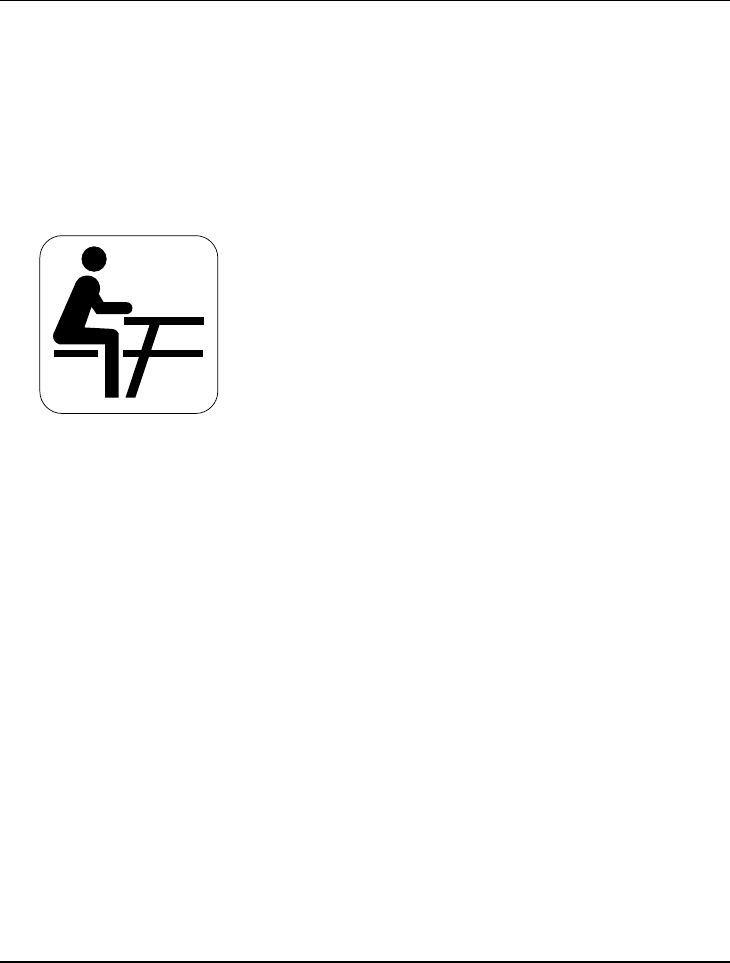
Notebook User Guide
5
About Your Notebook Computer
Congratulation for having purchased your new Professional
Multimedia Notebook. This notebook incorporates the
strongest features, which integrate the latest technologies
available in the notebook industry.
Your new notebook computer not only drives today
multimedia applications but also be ready for tomorrow
exciting new software.
This Professional Multimedia Notebook is a freedom,
flexibility, and functionality notebook that users are
demanding for a long time.
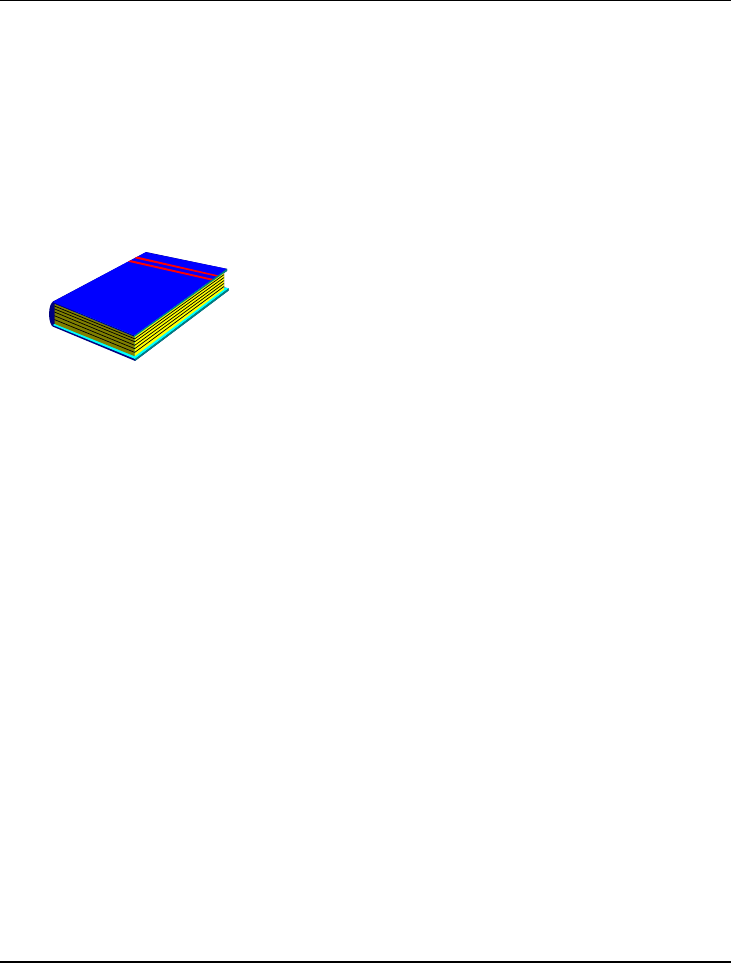
Notebook User Guide
6
About Your User Guide
Welcome to your Professional Multimedia Notebook User
Guide. This manual covers everything you need to know in
learning how to use your computer. This manual also
assumes that you know the basic concepts of Windows and
the PC. You will start doing a lot of great and fun things with
your computer.
This manual is divided into eight chapters.
Chapter 1 gives introduction on your computer features.
Chapter 2 provides step-by-step instructions to help you
begin using your notebook as quickly as
possible.
Chapter 3 describes how to operate the standard features
of your computer.
Chapter 4 illustrates how to integrate video and sound
chips into impressive presentation.
Chapter 5 illustrates how to connect external device to
your computer.
Chapter 6 explains how to use the System BIOS Setup
program.
Chapter 7 explains how to use the internal module
options of your computer.
Chapter 8 offers instructions on how to care and maintain
your notebook.

Notebook User Guide
7
Table of Contents
ABOUT YOUR NOTEBOOK COMPUTER.......................................... 5
ABOUT YOUR USER GUIDE................................................................. 6
1 INTRODUCTION............................................................................. 13
1.1 FEATURE HIGHLIGHT..................................................................... 14
1.2 UNPACKING THE COMPUTER ......................................................... 16
1.3 THE INSIDE OF THE NOTEBOOK ..................................................... 18
Notebook Status Icons .................................................................. 20
The Function of Easy Buttons....................................................... 22
1.4 THE FRONT SIDE OF THE NOTEBOOK ............................................. 23
1.5 THE REAR SIDE OF THE NOTEBOOK............................................... 23
1.6 THE LEFT SIDE OF THE NOTEBOOK................................................ 26
1.7 THE RIGHT SIDE OF THE NOTEBOOK.............................................. 27
1.8 THE UNDERSIDE OF THE NOTEBOOK.............................................. 28
1.9 NOTEBOOK ACCESSORIES.............................................................. 29
2 GETTING STARTED ...................................................................... 31
2.1 USING THE BATTERY PACK ........................................................... 32
Extending Battery Life.................................................................. 34
2.2 CONNECTING THE AC POWER SOURCE ......................................... 35
2.3 STARTING YOUR COMPUTER ......................................................... 36
2.4 ADJUSTING THE DISPLAY CONTROLS ............................................ 37
2.5 INSTALLING THE NOTEBOOK DEVICE DRIVERS ............................. 37
Installing Windows XP from Optical Disk Drive ......................... 38
Installing the Chipset Driver ........................................................ 38
Installing the VGA Device Driver ................................................ 39
Installing the Audio Device Driver............................................... 39
Installing the Modem Device Driver ............................................ 40

Notebook User Guide
8
Installing EzButton Utility............................................................ 40
Installing the Wireless LAN Device Driver and Utility ............... 41
Installing the LAN Device Driver................................................. 42
Installing ALPS - Touch Pad driver............................................. 43
Installing GV3 Driver................................................................... 43
2.6 TURNING OFF YOUR COMPUTER.................................................... 44
3 USING YOUR NOTEBOOK........................................................... 45
3.1 STARTING YOUR OPERATING SYSTEM .......................................... 46
3.2 UNDERSTANDING THE KEYBOARD FUNCTIONS ............................. 46
Basic Keyboard Functions ........................................................... 49
Cursor Control Keys .................................................................... 50
Screen Control Keys..................................................................... 51
Windows Hot Keys........................................................................ 52
Special Function Keys.................................................................. 52
3.3 USING THE GLIDE PAD POINTING DEVICE ....................................... 53
3.4 CONFIGURING YOUR SCREEN DISPLAY ......................................... 55
Possible Display Configurations.................................................. 56
Changing the Display Properties under Windows.................................. 56
3.5 KNOWING THE POWER SAVING FEATURES .................................... 57
3.6 WORKING WITH THE BUILT-IN HDD............................................... 58
3.7 HOW TO ACCESS THE OPTICAL DISK DRIVE .................................. 59
3.8 USING PCMCIA CARDS................................................................ 61
What is PCMCIA?........................................................................ 61
What is CardBus?......................................................................... 63
Inserting and Removing a PCMCIA Card ................................... 63
Making PC Cards Work ............................................................... 65
Hot Swapping PC Cards .............................................................. 66
4 FUN WITH MULTIMEDIA.................................................................. 67
4.1 NOTEBOOK MULTIMEDIA FEATURES............................................. 68

Notebook User Guide
9
4.2 AUDIO SOUND SYSTEM FEATURES ................................................ 68
4.3 SETTING UP THE AUDIO DRIVER PROPERTIES ............................... 69
4.4 WINDOWS MULTIMEDIA PROGRAMS ............................................. 69
4.5 RECORDING SOUNDS ..................................................................... 70
Using an External Microphone .................................................... 73
Using the Built-in Optical Disk Drive .......................................... 73
4.6 PLAYING AUDIO AND SOUND ........................................................ 74
Using the Windows Media Player ................................................ 75
4.7 PLAYING VIDEO AND MPEG FILES ............................................... 75
4.8 USING DVD .................................................................................. 76
5 CONNECTING TO PERIPHERALS ............................................. 79
5.1 USING A SERIAL PORT ................................................................... 80
5.2 CONNECTING A PARALLEL PRINTER .............................................. 81
5.3 USING AN EXTERNAL KEYBOARD (PS/2)............................................ 82
5.4 USING THE USB PORT................................................................... 83
5.5 USING AN EXTERNAL MONITOR PORT .................................................. 84
5.6 USING THE IEEE 1394 PORT ......................................................... 85
5.7 USING THE EXTERNAL AUDIO SYSTEM.......................................... 86
5.8 USING THE LAN PORT .................................................................. 87
5.9 USING THE WIRELESS LAN........................................................... 88
5.10 USING THE MODEM PORT .............................................................. 89
6 CUSTOMIZING YOUR NOTEBOOK.............................................. 91
6.1 RUNNING THE BIOS SETUP PROGRAM .......................................... 92
6.2 USING THE MAIN MENU SETUP ..................................................... 94
6.2.1 Internal HDD Sub-Menu.................................................. 97
6.3 USING THE ADVANCED CMOS SETUP........................................... 97
6.3.1 I/O Device Configuration Sub-Menu........................... 100
6.4 SECURITY MENU SETUP .............................................................. 101
6.5 USING THE BOOT SETUP .............................................................. 104

Notebook User Guide
10
6.6 HOW TO EXIT THE SETUP PROGRAM ........................................... 105
6.7 HOW TO UPGRADE THE BIOS...................................................... 106
7 USING OPTIONS ........................................................................... 109
7.1 SYSTEM UPGRADE....................................................................... 110
Memory Upgrade ....................................................................... 110
Installing Memory Module ......................................................... 111
7.2 HARD DISK UPGRADE ................................................................. 112
Upgrade Hard Disk .................................................................... 112
7.3 WIRELESS MODULE INSTALLATION............................................. 114
8 CARING FOR YOUR NOTEBOOK............................................ 115
8.1 IMPORTANT SAFETY INSTRUCTIONS ............................................ 116
8.2 CLEANING YOUR COMPUTER ...................................................... 118
8.3 MAINTAINING THE LCD QUALITY .............................................. 119
8.4 MAINTAINING YOUR HARD DISK ................................................ 119
8.5 BATTERY CARE GUIDELINES....................................................... 120
8.6 WHEN YOU TRAVEL.................................................................... 121
APPENDIX A SYSTEM SPECIFICATION...................................... 123
Processor Unit............................................................................ 124
System Memory........................................................................... 124
LCD Display............................................................................... 124
VGA System ................................................................................ 124
Storage........................................................................................ 125
Audio System .............................................................................. 125
PCMCIA ..................................................................................... 125
Glide Pad.................................................................................... 125
Keyboard .................................................................................... 125
Flash BIOS ................................................................................. 126
I/O Ports..................................................................................... 126

Notebook User Guide
11
Wireless devices.......................................................................... 126
AC/DC Power Supply Adapter ................................................... 126
Battery ........................................................................................ 126
Weight and Dimension ............................................................... 127
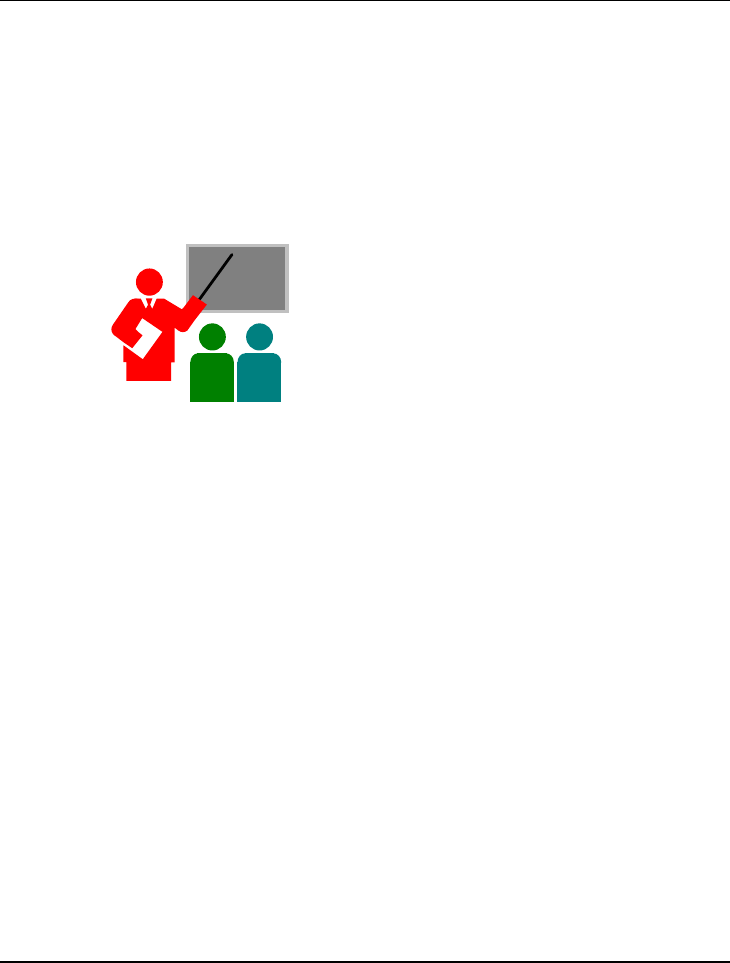
Introduction1
13
1 Introduction
Your Notebook PC is a fully Windows compatible
portable personal computer. With the latest features
in mobile computing and multimedia technology, this
notebook makes a natural traveling companion. With
leap of technology and compact, your Notebook PC
runs on a whole wide range of general business,
personal productivity, entertainment, and professional
applications. It is ideal for use in the office, at home,
and on the road.
Your Notebook PC makes an ideal choice for use in
the office, the schoolroom, at home, on the road and
all other occasions.

Notebook User Guide
14
1.1 Feature Highlight
Before we go to identify each part of your Notebook PC, we will first
introduce you to other notable features of your computer.
This notebook uses the platform with certified Intel® Centrino™ Mobile
Technology. It supports the new Intel® Pentium® M processor, the core-logic
architecture that absolutely fits the processor and the built-in excellent Intel®
PRO/Wireless solution.
The Centrino™ Mobile Technology is a new concept of N/B that is capable
of power-saving long operation time and easy accessing wireless connection.
The CPU is specialized design for power saving feature with adequate speed.
You can get the same powerful performance as high speed Intel Pentium® 4,
yet without consuming so much energy.
Processing Unit
• Your notebook runs on Intel Pentium® M microprocessor which is
integrated with 1024 KB L2 Cache. Check with your dealer on the CPU
type and speed.
• Fully compatible with an entire library of PC software based on operating
systems such as Windows 2000/XP.
Wireless LAN
Intel® Pro/Wireless network solution
Memory
This notebook provides two memory slots for installing DDR SDRAM 200-
pin SODIMM modules up to 1024MB using 128MB, 256MB or 512MB DDR
SDRAM modules

Introduction1
15
PCMCIA
Provides two PCMCIA slots that allow you to insert the Type II card
IEEE 1394
Provides one IEEE 1394 port for fast data transmission by external hard disk
or digital video (DV)
USB 2.0
Provides three USB 2.0 ports for fastest I/O data transmission
Graphic System
Provides blazing graphics controller embedded in Intel Montara-GM chipset
PCI Local Bus Architecture
• 32-bit PCI Enhanced IDE optimizes the data transfer between the CPU
and hard disk drives. Support ultra DMA 100 PIO Mode up to PIO Mode
4, bus mastering for LBA Scheme.
• 32-bit PCMCIA CardBus PCI technology that is also backward
compatible with 16-bit PC cards.
Audio System
Full-duplex 16-bit stereo audio system output. Sound Blaster and Sound
Blaster Pro compatible.
Flash BIOS
Flash BIOS allows you to easily upgrade the System BIOS using the Phoenix
Flash utility program.

Notebook User Guide
16
Power and System Management
• Integrated SMM (System Management Mode) on system chipset that shuts
down components not in use to reduce power consumption. To execute
power management, you can set up the parameter in Power Options
properties by pointing your mouse to Control Panel of Windows.
• Suspend hot-key allows you to suspend the system operation instantly and
resume at the press of the power button.
• System Password for User and Supervisor included on the BIOS SETUP
Program to protect unauthorized use of your computer.
1.2 Unpacking the Computer
Your computer comes securely packaged in a sturdy cardboard shipping
carton. Upon receiving your computer, open the carton and carefully remove
the contents. In addition to this User Guide, the shipping carton should also
contain the following items:
The Notebook Computer
An AC Adapter and AC Power Cord
Li-Ion Battery Pack
Utility CD
Hardcopy User Guide/E-book
Quick Setup Manual

Introduction1
17
Carefully inspect each component to make sure that nothing is missing and/or
damaged. If any of these items is missing or damaged, notify your dealer
immediately. Be sure to save the shipping materials and the carton in case you
need to ship the computer or if you plan to store the computer away sometime
in the future.
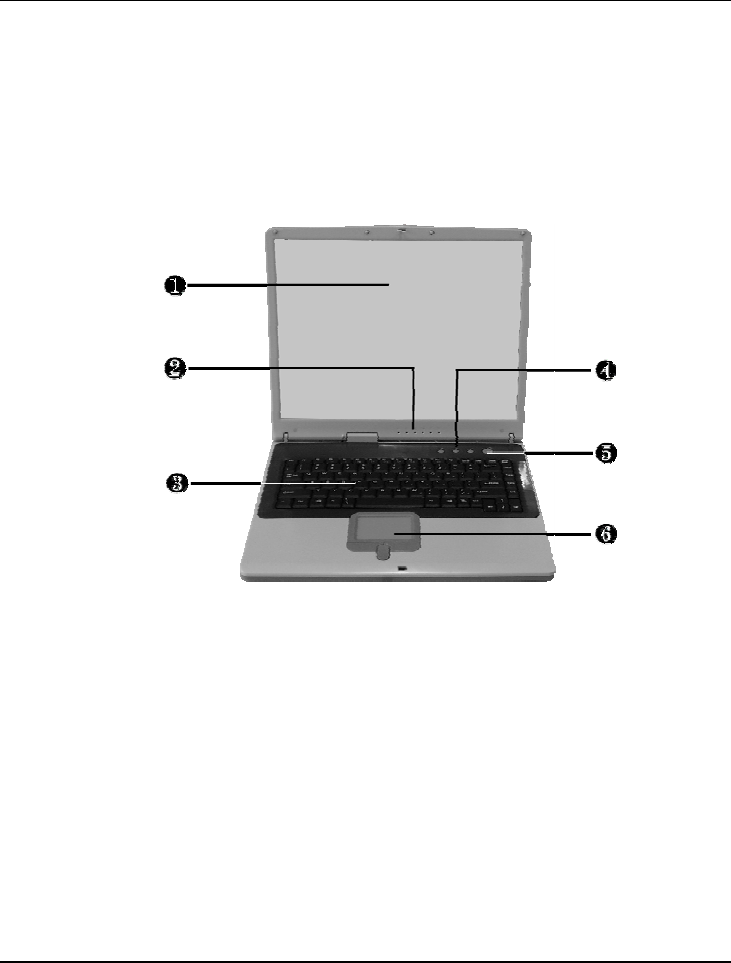
Notebook User Guide
18
1.3 The Inside of the Notebook
The notebook computer is compact with features on every side. First, look
at the inside of the system. The following sections describe inside features.
1. Color LCD Display 2. Status LED Indicator
3. Keyboard 4. Easy Buttons
5. Power On/Resume Button 6. Touchpad Pointing Device
• Color LCD Display
The notebook computer comes with a color LCD that you can adjust for a
comfortable viewing position. The LCD can be 15" TFT color LCD with
1024x768 XGA (Extended Graphics Array) or 1280 X 1024 SXGA+
(Super Extended Graphics Array) resolution panels. The features of the
Color LCD Display are summarized as follows:

Introduction1
19
➟ TFT color LCD with 15" 1024x768 XGA or 1280 X 1024 SXGA+
resolution panels.
➟ Capable of displaying 16M colors (32-bit true color) on either size
panels.
➟ LCD display control hot-keys allows you to adjust the brightness of
the LCD.
➟ Simultaneous display capability for LCD and external desktop
computer monitor.
• Status LED Indicator
Keeps you informed of your notebook computer’s current operating
status and power status. Description of the status icons appears in the
latter part of this section.
• Keyboard
➟ Standard QWERTY-key layout and full-sized 88 keys keyboard with
Windows system hot-keys, embedded numeric keypad, 7 hot keys,
inverted "T" cursor arrow keys, and separate page screen control
keys.
➟ Wide extra space below the keyboard panel for your wrist or palm to
sit-on comfortably during typing.
• Easy Buttons
There are three easy buttons used for activating wireless function and
accessing user-defined functions instantly and easily. Description of the
easy buttons appears in the latter part of this section.
• Power On/Resume Button
Switches the computer power on and off, or resumes whenever it is in
Suspend mode.
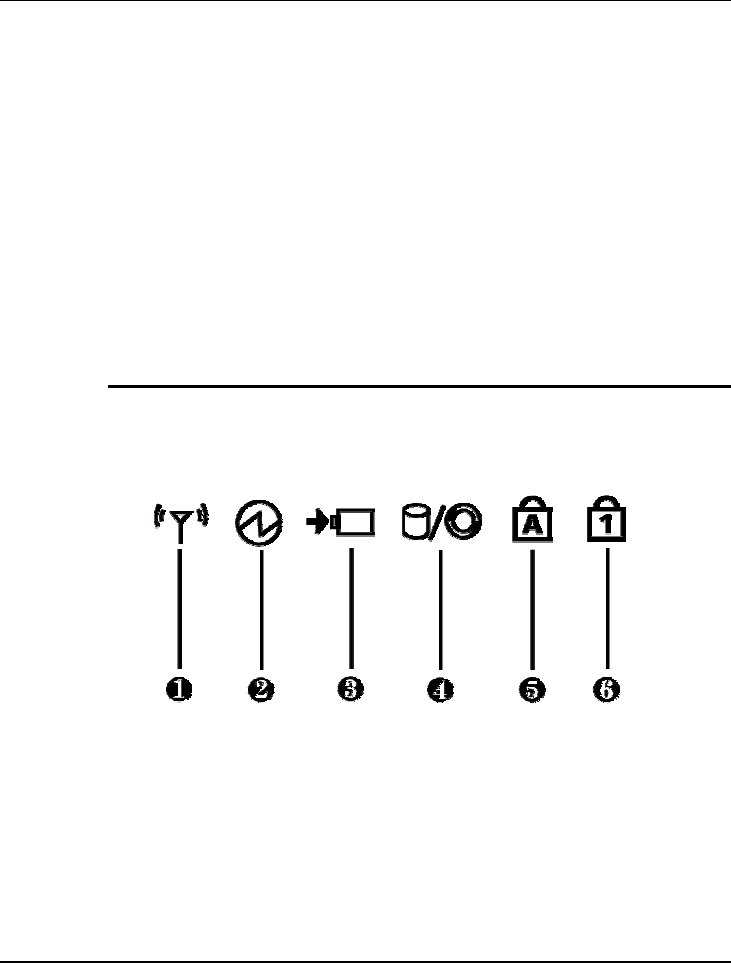
Notebook User Guide
20
• Touchpad Pointing Device
Microsoft and IBM PS/2 mouse compatible with three select buttons as
one Scroll button and two Touchpad click buttons. These three buttons
array below the Glide pad. The middle one is located with the Scroll
button that lets you execute the scroll page function. The two click
buttons located at each side support tapping selection and dragging
functions. These buttons work like a standard computer mouse. Simply
move your fingertip over the Glide Pad to control the position of the
cursor. Use the selection buttons below the Glide Pad to select menu
items.
NOTEBOOK STATUS ICONS
The Status LED Panel keeps you informed of the notebook’s current
operating and power status. Each LED is marked with an icon to designate the
system status.
1. Wireless LAN Status 2. Power Indicator
3. Battery Charging LED 4. HDD/CD Access
5. Caps Lock 6. Num Lock
• Wireless LAN Status
When LED in green light indicates that the system is accessing data from
or is retrieving data by wireless LAN.

Introduction1
21
• Power Indicator
Lets you know that power to the system is turned on. This LED is
positioned so that you can see the power state whether the LCD panel is
opened or closed.
➟ Lights green when the system is powered on.
➟ Lights green blinking when the system is in Suspend to RAM.
• Battery Charging LED
Lights to indicate battery in charging status.
➟ Lights green to indicate that the battery is in charging.
➟ Lights off to indicate the battery is fully charged or no battery
installed.
• HDD/CD Access
When LED in green light indicates that the system is accessing either the
Hard Disk or optical disk drive.
• Caps Lock
When LED in yellow light indicates that the Caps Lock key on the
keyboard is activated. When activated, all alphabet keys typed in will be in
uppercase or capital letters.
• Num Lock
When LED in yellow light indicates that the Num Lock key on the
keyboard is activated. When activated, the embedded numeric keypad will
be enabled.
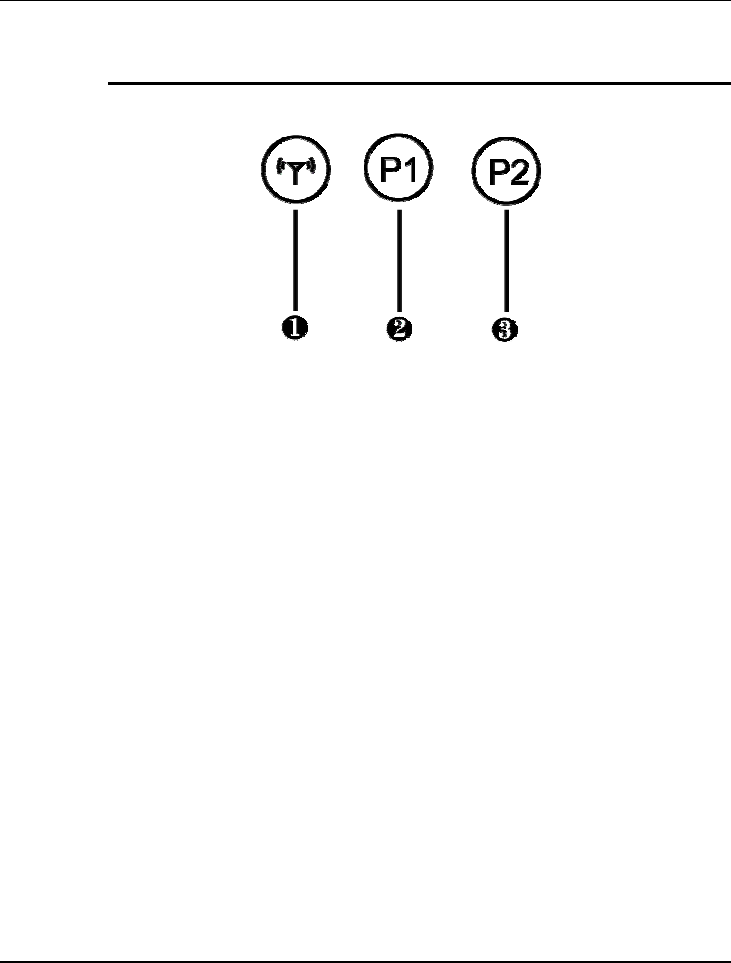
Notebook User Guide
22
THE FUNCTION OF EASY BUTTONS
1. Wireless LAN Button 2. Easy Button 1 3. Easy Button 2
• Wireless LAN Button
Push this button to activate or inactivate the Wireless LAN. When you
activate the wireless LAN function, it will search the wireless LAN signal
automatically if you had installed the driver.
• Easy Button 1
You can define the specific function by yourself to active the program.
For example, you can define it to access the outlook 98/2000/2002...
utility just by pressing this button. You can simplify several procedures in
entering into Outlook 98/2000/2002... environment. For more
understanding and interesting, you can refer Section 2.5 to recognize the
driver installation procedures in activating Easy Button 1.
• Easy Button 2
You can define the specific function by yourself to active the program.
For example, you can define it for providing a very convenient way in
connecting Internet only by pressing this button. For more understanding
and interesting, you can refer Section 2.5 to recognize the driver
installation procedures in activating Easy Button 2.
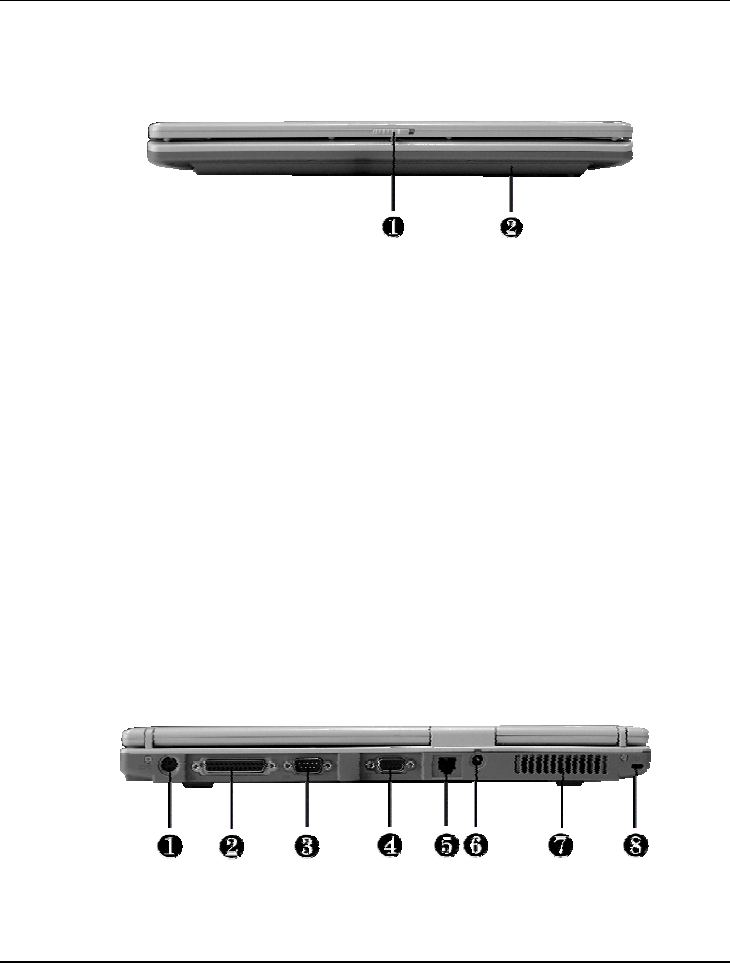
Introduction1
23
1.4 The Front Side of the Notebook
1. Cover Switch 2. Battery
• Cover Switch
The cover (LCD panel) is locked when it is closed. Slide the button right
aside to release the latch for opening the cover of the computer.
• Battery
The battery provides the power for the N/B when there is no AC power
available. Please refer to chapter 2.1 for how to attach and detach the
battery.
1.5 The Rear Side of the Notebook
The system ports at the back of your notebook computer can connect various
devices. Each port is described as followings.
1. PS/2 Port 2. Print Port 3. COM Port

Notebook User Guide
24
4. VGA Port 5. Modem Port 6. DC-In Port
7. Air-Outlet Vent 8. Locking Device Keyhole
• PS/2 Port
Lets you connect an external PS/2-style mouse, PS/2-style keyboard, or
PS/2-style numeric keypad to the system. With an optional Y-cable
adapter, you also can connect any combination on two of these devices
simultaneously.
• Print Port
Use this port to connect a parallel printer or other parallel device. The
parallel port supports Enhanced Capabilities Port (ECP) standard. The
standard provides you with a greater processing speed than the
conventional parallel port. The port also supports bi-directional protocols.
☞
The default setting for the parallel port on your notebook computer is set to
Enhanced Capabilities Port (ECP). Some older parallel devices may not
function with the ECP default setting. You may need to adjust the setting to
accommodate your parallel device by changing the BIOS setting.
• COM Port
Lets you connect a 9-pin external serial device such as a PDA, mouse, or
other serial devices.
• VGA Port
Lets you attach an external CRT monitor for wider display. You can run
the LCD display and the external CRT monitor simultaneously or switch it
to CRT only using the display hot-key.
• Modem Port
A 56K internal fax/data modem is installed. It keeps you connected to the
outside world through networks.

Introduction1
25
• DC-In Power Port
Lets you connect the AC power adapter in supplying continuous power to
your notebook and recharging the battery.
• Air-Outlet Vent
Emits the heat out of your computer and keeps it within operating
temperature.
• Locking Device Keyhole
Lets you attach a Kensington security system or a compatible lock to
secure your notebook computer.
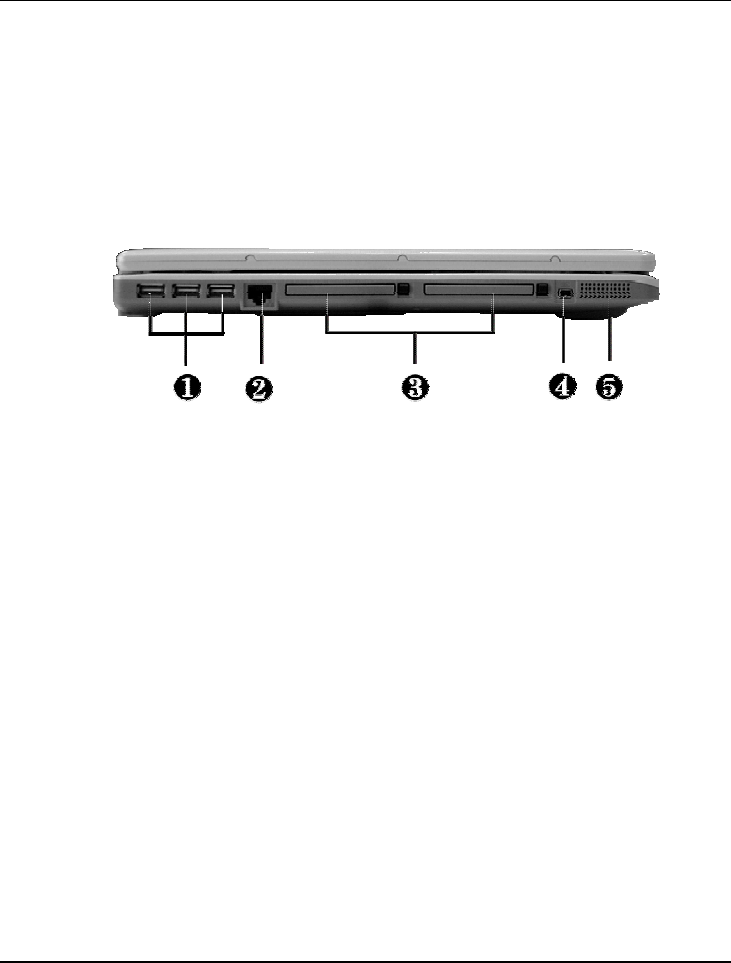
Notebook User Guide
26
1.6 The Left Side of the Notebook
The left side of your notebook computer provides the features shown in the
following figure.
1. USB Port 2. LAN Port
3. PC Card Slot 4. IEEE 1394
5. Built-in Stereo Speakers
Left Side Features
• USB Port
The Universal Serial Bus (USB) port allows you to connect up to 127
USB-equipped peripheral devices (for example, printers, scanners and so
on) to your notebook computer.
• LAN Port
An internal 10Base-T/100Base-TX LAN module connects your computer
to other computers/networks through a local area network (LAN).
• PC Card Slot
➟ Lets you connect various PC cards such as memory card
➟ Supports both 3V, 5V 32-bit CardBus and 16-bit PC cards.
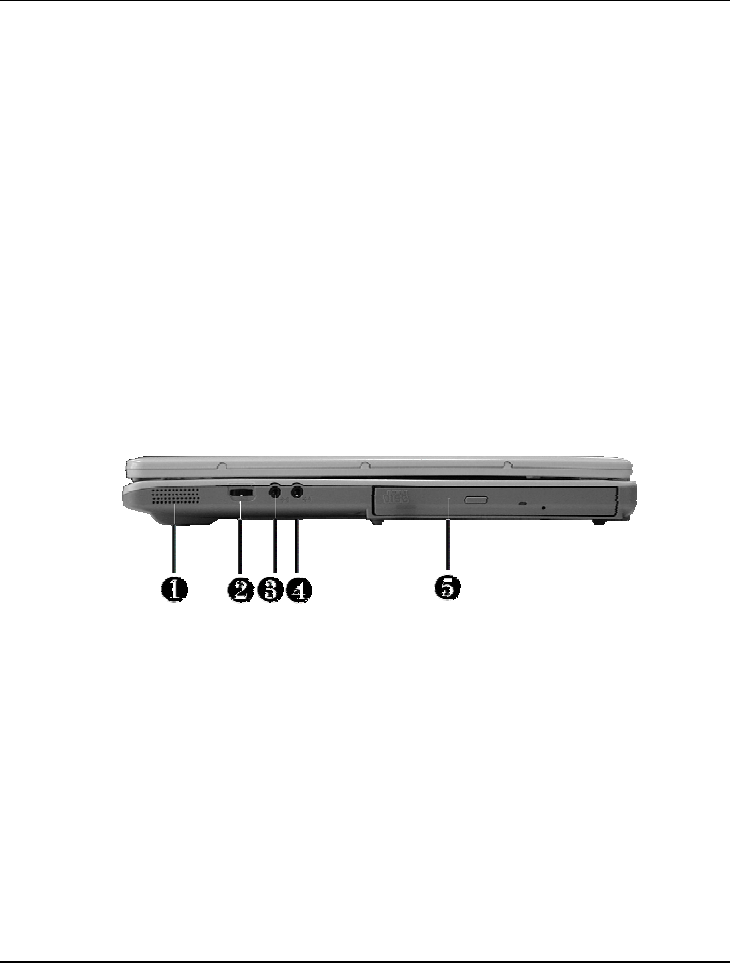
Introduction1
27
• IEEE 1394
IEEE 1394 port is a high speed I/O port that can transfer high levels of
data in real-time, such as external hard disk, Digital Video Camera.
• Built-in Stereo Speakers
Integrated left and right mini stereo speakers located at the two sides of
the N/B for sound and audio output for your multimedia presentations or
listening pleasure.
1.7 The Right Side of the Notebook
The right side of the notebook computer offers the features shown in the
following figure.
1. Built-in Stereo Speakers 2. Volume Control
3. Microphone Jack 4. Headphone Jack
5. Optical Disk Drive.
Right Side Features
• Built-in Stereo Speakers
Integrated left and right mini stereo speakers located at the two side of the
N/B for sound and audio output for your multimedia presentations or
listening pleasure.
• Volume Control
Allows you to control the speaker volume.
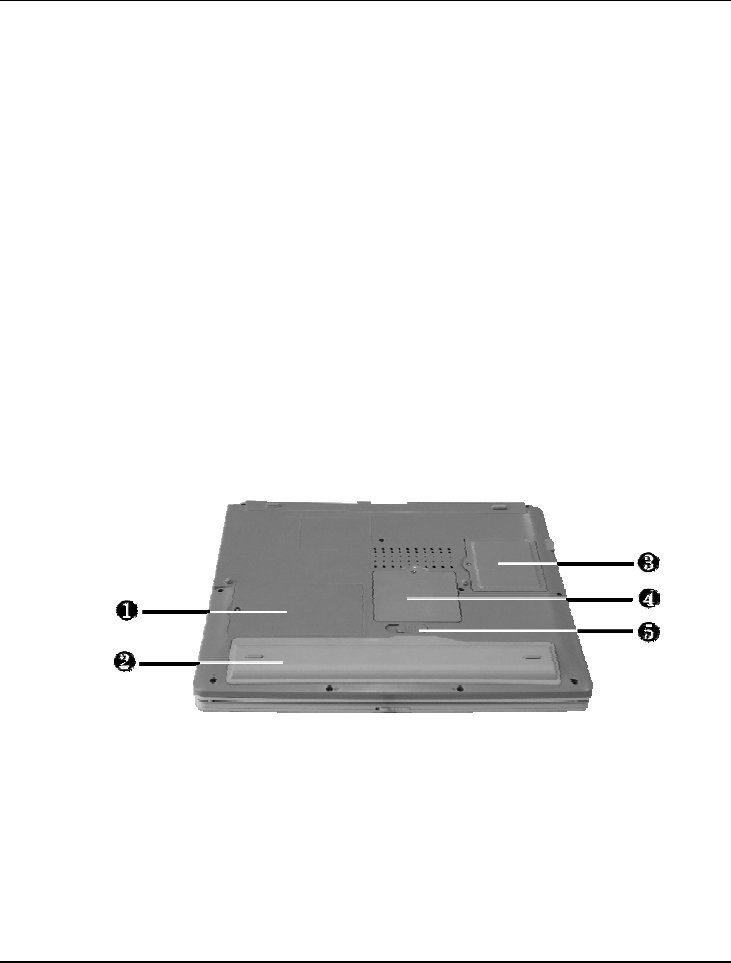
Notebook User Guide
28
• Microphone Jack
Allows you to connect an external microphone for monophonic sound
recording directly into your notebook computer.
• Headphone Jack
Lets you plug in a stereo headphone, powered speakers, or earphone set
with 1/8 inch phono plug for personal listening.
• Optical Disk Drive
Allows you to load and start programs from a compact disc (CD) or a
digital video disc (DVD) and play conventional audio CDs. It also can
make CD by using CD-R or CD-RW.
1.8 The Underside of the Notebook
The bottom of the notebook computer offers the following features.
1. Hard Disk Compartment 2. Battery Bay
3 Wireless LAN Compartment 4. Memory Compartment
5. Battery Release Latch
Bottom of the System

Introduction1
29
• Hard Disk Compartment
Open this cover of this compartment to replace with other Hard Disk
Drive. Please refer to Chapter 7 for how to replace it.
• Battery Bay
Equipped with a choice of Lithium-Ion (Li-Ion) battery pack.
• Wireless LAN Compartment
Provides optional wireless LAN card inserted into this compartment for
executing relative functions.
• Memory Compartment
Remove the screw to find two DIMM slots. One is inserted with DDR
SDRAM memory board configured by the factory. The other is empty for
upgrade use.
• Battery Release Latch
Push the latch to the left end to remove the battery pack.
1.9 Notebook Accessories
AC Adapter
The AC Adapter supplies external power to your notebook computer and
charges the internal battery pack simultaneously. The AC adapter has an auto-
switching design that can connect to any 100VAC ~ 240VAC power outlets.
You just change the power cord if you are going to use your notebook in other
countries with different connector outlets.
When you connect the AC adapter, it charges the battery whether or not the
notebook computer is powered on.

Notebook User Guide
30
Battery Pack
Aside from the AC adapter, your computer can also be powered through the
internal battery pack. The battery pack uses rechargeable Lithium-Ion (Li-Ion)
battery cells that provide long computing hours when fully charged and power
management enabled. You should always leave the battery inside your
computer even when using the AC adapter as it also acts as a back-up power
supply in case power from the AC adapter is cut off. It is also very important
to have the battery pack always charged to prevent battery cell degradation.
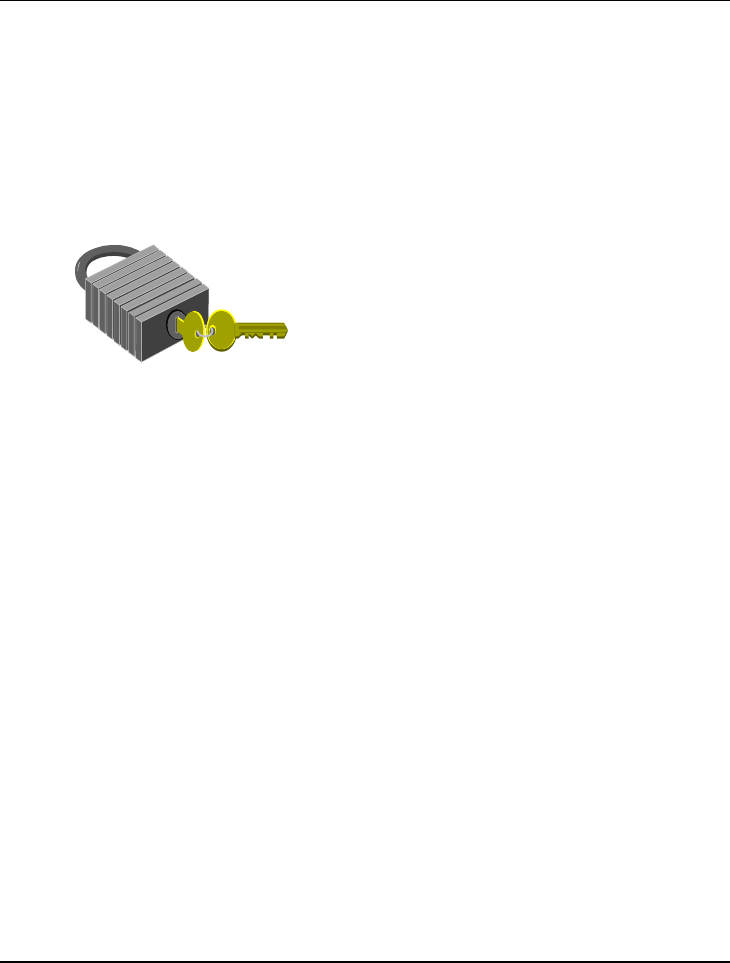
Getting Started 2
31
2 Getting Started
Your Notebook is designed and pre-configured for
easy setup and use. This chapter describes the
installation steps you should follow to get the
notebook up and running as quickly as possible.
Contact your dealer if they have pre-installed all the
needed drivers to fully operate your computer or if
there is an update on the driver installation of the
notebook.

Notebook User Guide
32
2.1 Using the Battery Pack
The notebook is designed to operate with one of the following power sources:
• With AC power using the AC adapter connected to an electrical outlet.
• With a Lithium-Ion (Li-Ion) battery pack.
You should use the AC adapter whenever it is possible, relying on the battery
pack only when AC power is unavailable.
Before you use your notebook computer, install and recharge the battery pack
first. The rechargeable Li-Ion battery pack allows you to operate the notebook
without an external power source. When you connect the AC power adapter,
the battery immediately starts to recharge. Normal battery life is 4 hours for
Lithium-Ion (Li-Ion) battery pack.
For maximum battery performance, fully discharge the battery first before
recharging it when you start to use it first time. To do so, unplug the AC
adapter, turn off power management features (through Setup and Windows),
and turn on the system. Once the battery is fully discharged, plug in the AC
adapter and recharge the battery.
If you do not discharge the battery completely, it fails to accept a full recharge.
☞
Li-Ion battery is vulnerable, do not charge it with other power adapter, or it
may cause fire or explosion.
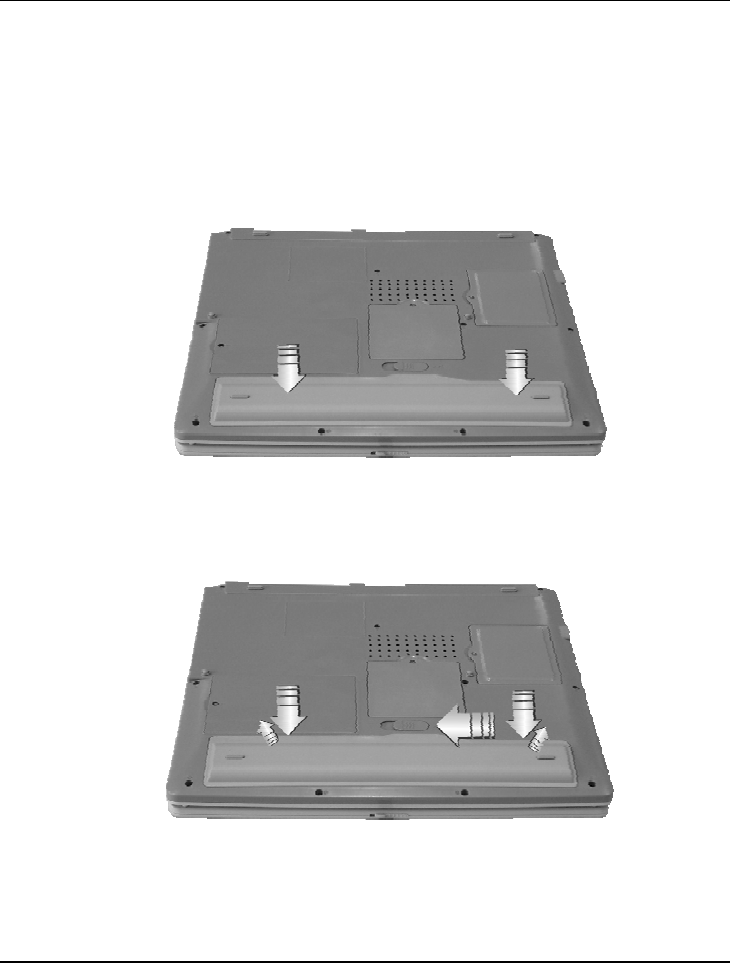
Getting Started 2
33
Installing the Battery Pack
This notebook provides the most convenient way to install the battery pack
into your computer. With the extended nose directed toward the
compartment, insert and push the battery pack.
Removing the Battery Pack
To remove the battery pack, slide the latch to the end of left side to pop-out
the battery pack, and then take out the battery pack with your finger.

Notebook User Guide
34
Replacing the Battery Pack
When your notebook estimates that the battery only has enough charge to
continue for a few minutes, it will alert you with a battery low warning beep. If
you are consuming a lot of power by using the audio system, the PCMCIA
slots, the hard disk drives, and optical disk drive, your notebook might run out
of charge much sooner than you expect. You should always respond to the
battery low indication by connecting to AC power or turning off your
notebook, or suspending your notebook to disk. If you do not do so, the
notebook will automatically suspend to disk and turn off. The contents of the
memory will store in the hard disk drive. You will be unable to restart the
notebook until you have connected to the AC adapter or installed a charged
battery. To replace the battery pack, refer to the previous sections on
"Installing the Battery Pack" and "Removing the Battery Pack."
☞
For Window 2000/XP, the suspend mode (Hibernate or Standby) can be
chosen at Power Options of Windows's Control Panel)
☞
Be sure to save your data before replacing the battery pack or connecting
the AC adapter. Failure to do so can result in data loss.
EXTENDING BATTERY LIFE
It is important to be aware of the simple things for extending the life of the
system main battery while you are on the road. You should find a working
place where the external lighting is not too bright and turn down the screen
brightness. Also, you can choose the available mode on the Power
Management item of the Control Panel in Windows.
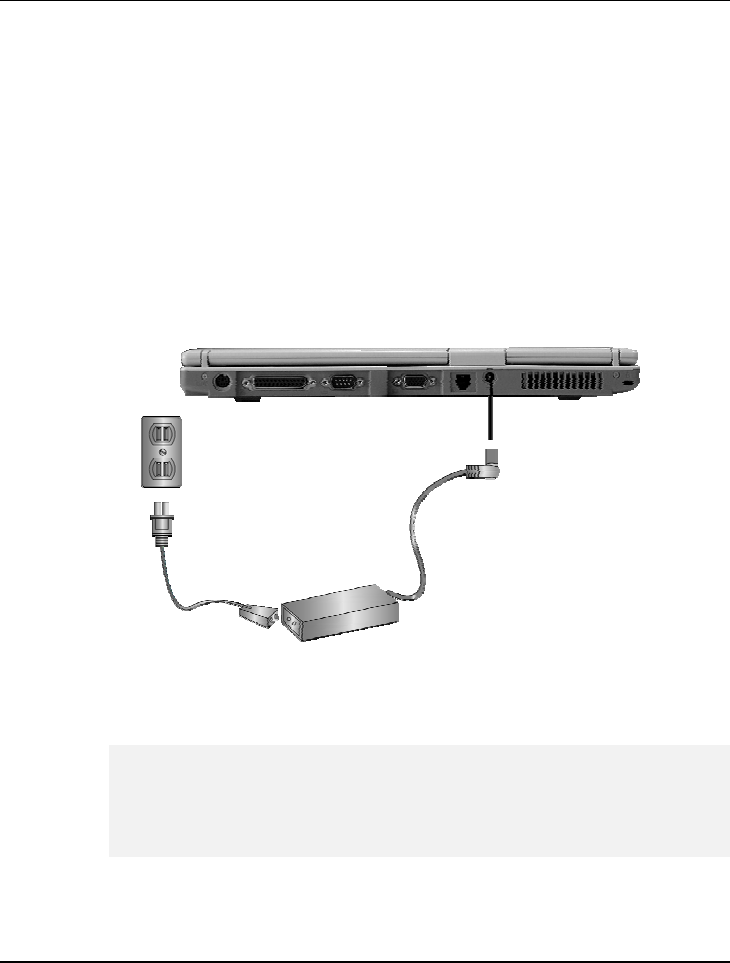
Getting Started 2
35
2.2 Connecting the AC Power Source
The AC adapter provides external power source to your computer and charges
the internal battery pack at the same time. The AC adapter also has an auto-
switching design that can connect to any 100VAC ~ 240VAC power outlets.
To connect the power adapter:
1. Plug the AC power cord into the power socket of the AC power adapter.
2. Plug the other end of the AC power cord to a live AC wall outlet.
3. Plug the connector of the AC adapter to the DC-IN port found at the rear
side of the computer.
☞
Whenever possible, it is advisable to always have the AC adapter connected
to the notebook and the battery pack installed. This ensures continuous
power supply and prevents any data loss incurring from sudden power
breakdown.
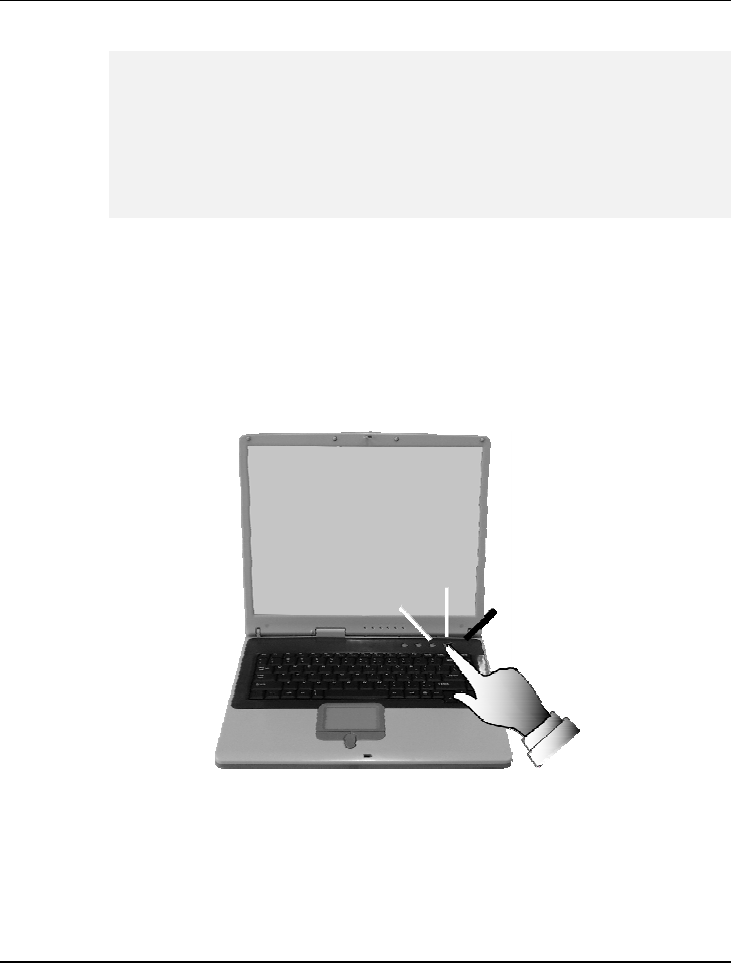
Notebook User Guide
36
☞
For the power supply of this equipment, an approved power cord has to
be used.
Make sure the socket and any extension cord(s) you use can support
the total current load of all the connected devices.
Before cleaning the computer, make sure it is disconnected from any
external power supplies (i.e. AC adapter).
2.3 Starting Your Computer
The Power/Resume button is found on the top of the base unit. Press the
Power/Resume button to start your computer and check that if the Power
LED turns on.
After a few seconds, the computer’s display will turn on and your computer
will begin to execute the Power On Self Test or POST to check if all system
components are running properly. Any error found during the test will be
displayed on the screen and may generate short beep sound as well.

Getting Started 2
37
After the test, the screen will also display a message "press <F2> to enter
SETUP". You don’t need to run this program at the moment as your dealer
already made the necessary settings for your computer optimal operation.
Refer to Chapter 6 on running the SETUP program later.
After the test has completed, your computer will start to search and boot up
the operating system from your hard drive. The notebook computer normally
comes with a Windows operating system pre-installed in your hard drive.
Consult the Windows manual on how to use the program. If not, contact your
dealer for assistance.
2.4 Adjusting the Display Controls
The LCD brightness adjustment is controlled by <Fn> +<F8> and <Fn> +
<F9> keys respectively. You need to press these hot-key controls after
powering on your notebook to suit your viewing pleasure.
The Brightness hot-key control adjusts the brightness on the LCD. The
brightness hot-key control will not set the LCD completely dark or bright; it
provides sufficient lighting to the LCD to match the external lighting of the
surrounding. The brighter the room, the more you need to increase the
brightness of the LCD.
2.5 Installing the Notebook Device
Drivers
If you already have an operating system installed into your notebook
computer, it is best to install the needed device drivers for using the built-in
devices of your computer. Before installing the drivers, check with your dealer

Notebook User Guide
38
first if they have already installed all the drivers along with the operating
system. If not, follow the procedures below:
INSTALLING WINDOWS XP FROM OPTICAL DISK DRIVE
To install Windows XP directly from your optical disk drive, please go to Boot
menu of BIOS setup menu. Use arrow key to select "CD-ROM Drive", then
use "+" or "-" to move it to the top. Go to Exit menu and select "Exit
Saving Changes". Accordingly, insert the Windows XP installation CD into
optical disk drive with following the instructions on the screen to finish the
installation.
INSTALLING THE CHIPSET DRIVER
Your notebook computer uses the advanced chipset. Installing the driver to
enhance the stability and performance.
Installing Chipset device driver for Windows XP
1. Click the Start button, then point to Run. The Run dialog box appears.
2. Click the Browse button and specify the directory as.
"E:\Drivers\WinXP\Chipset\Setup.exe".
3. Click "OK" to execute the setup program. The Setup box appears.
4. Click “Next” continuously to install this driver when screen displays this
command.
5. Click “Yes” to accept the License Agreement .
6. Click “Next” to continue the following step.
7. Tick the option "Yes, I want to restart my computer now.",
and press Finish to restart your system.